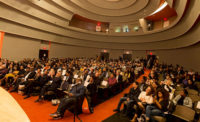Boston's young and mid-career practices find common ground in their training and research-based design.
The Next Wave
Boston’s next wave of architects is nationally, culturally, and ideologically diverse. They are drawn to the city by its schools and united in their intensive quest for formal and material expression. Judging by precedent, one would expect to see these firms blossom in the 2010s and beyond—but some are already breaking the mold.

The Galante Architecture Studio
On graduating in 1993 from the Cranbrook Academy of Art, in Michigan, Ted Galante, AIA, worked there as resident architect for an elementary school designed by The Office of Peter Rose, based in Cambridge, Massachusetts, where he set up his firm. A New Yorker, Galante grew up in a family of builders, learning steel fabrication and construction firsthand. Along with his Cranbrook training, he has an understanding of material and craft that subtly imbues the form and material in his work with reassuring technical competence. While Galante has a local portfolio of private residences and municipal buildings, New York City’s Design Excellence program—through which he has designed three fire stations, among other works—has allowed him to expand his practice geographically.
Merge Architects
Merge Architects is composed of principal Elizabeth Whittaker, Assoc. AIA—a Harvard GSD graduate who once worked with Brian Healy and, in Los Angeles, with Frank Gehry, FAIA—and vice president Stephen Zecher, with a staff of three. Founded in 2005, it has graduated from designing stylish interiors to a growing portfolio of residential development. Whittaker believes passionately in professional and client collaboration, hence the name of the practice. Her involvement in the BSA, and her leading role in creating the Young Boston installation for this year’s AIA convention, shows Whittaker’s commitment to engaging owners, builders, community, and designers in the “particularity of a project” as the generative path to high design. Merge experimented with acting as general contractor on some early projects but now prefers a less-ambitious design-build collaboration.
O’Hagan Architects
Audrey O’Hagan, AIA, came to the city neither as a student—she graduated from the University of Kansas—nor as a recent graduate, since she had already spent 10 years as an architect in the United Kingdom. Knowing no one here when she arrived, O’Hagan networked through the BSA, became a principal at Stubbins Associates, and eventually set up on her own in 2007. She is already capitalizing on her experience and local contacts, quickly securing commercial commissions as well as the residential and interior work common to start-up practices. What O’Hagan finds attractive in the Boston scene is the constant presence of big name architects working for major institutions, as well as the increasing influence of the smart high-tech and biotech presence in the city. Her work with Stubbins on the Novartis Institutes of BioMedical Research, in Cambridge, represents one outcome of this influence.
over,under
over,under embodies eclectic practice. Consisting of a British-born Canadian, an Egyptian, a Colombian-born Swiss, and an American—Chris Grimley, Rami el Samahy, Roberto de Oliveira Castro, and Mark Pasnik, respectively—the partnership has woven itself together via Harvard GSD, which three out of its four principals attended, and Machado and Silvetti (four out of four). As if reflecting this polyvalent provenance, over,under invented itself as a multidisciplinary studio for architecture, furniture design, and graphic and Web design, as well as as a publishing and art gallery concern. over,under has designed a residence under construction in Guatemala and is working on a master plan in Qatar. Its pinkcomma gallery has curated exhibitions that include Rethinking City Hall—with ArchitectureBoston—and, with Utile, it has published a compendium of recent Boston residential projects called Urban Housing Atlas. While over,under pursues the realities of practice, pinkcomma is intended as agitprop: an underground organization to foster and recognize a “more creative, youthful, and experimental scene” in Boston nurtured by the universities.
Studio Luz
Founded in 2001, Studio Luz is led by husband-and-wife team Anthony Piermarini, AIA, and Hansy Better Barraza, AIA, who met at Cornell and continued through the Harvard GSD together [record, December 2006, page 80]. While cutting their teeth in the profession, Piermarini worked with Kennedy & Violich, and Barraza with Office dA. In their own practice, the formal aspect of their interiors work clearly shows this provenance in the creative use of light and material. But it is through their social engagement that they add another dimension to their portfolio of built projects and installations. In addition to working with nonprofit groups making urban interventions in Boston and Somerville, Massachusetts, Studio Luz has worked with Hope for the Children of Haiti to develop a master plan and design for an orphanage, school, and clinic in Port-au-Prince, Haiti. During an era in which high design and social responsibility often take divergent paths, Studio Luz is a refreshing reminder that these are not mutually exclusive pursuits.
Utile
Founded in 2002, Utile has four partners, all ex-Machado and Silvetti—Mimi Love, Michael LeBlanc, AIA, Time Love, AIA, and Matthew Littell—and 16 employees. The firm’s approach is to develop a specific expertise in multifamily urban housing and leverage that into the development world and the expanded scope of developer-pragmatic urban design. Utile has now established itself as the leading proponent of edgy, European-style housing throughout the Boston area. Teaching at Northeastern University and, with over,under, publishing the Urban Housing Atlas, are all facets of the firm’s single, focused strategy. Now that the residential market is softening, the practice is taking a similar approach to the commercial market.



Post a comment to this article
Report Abusive Comment